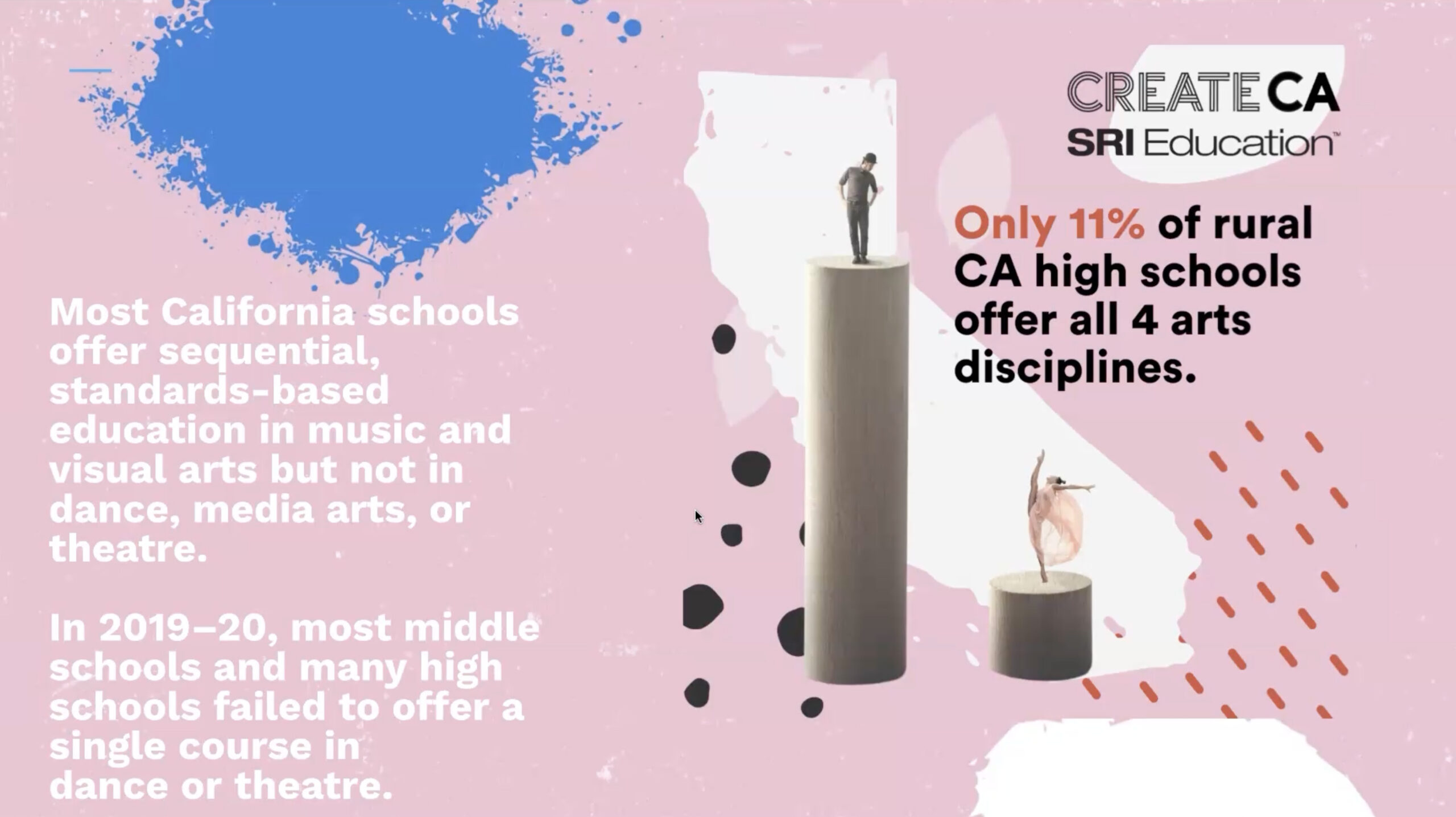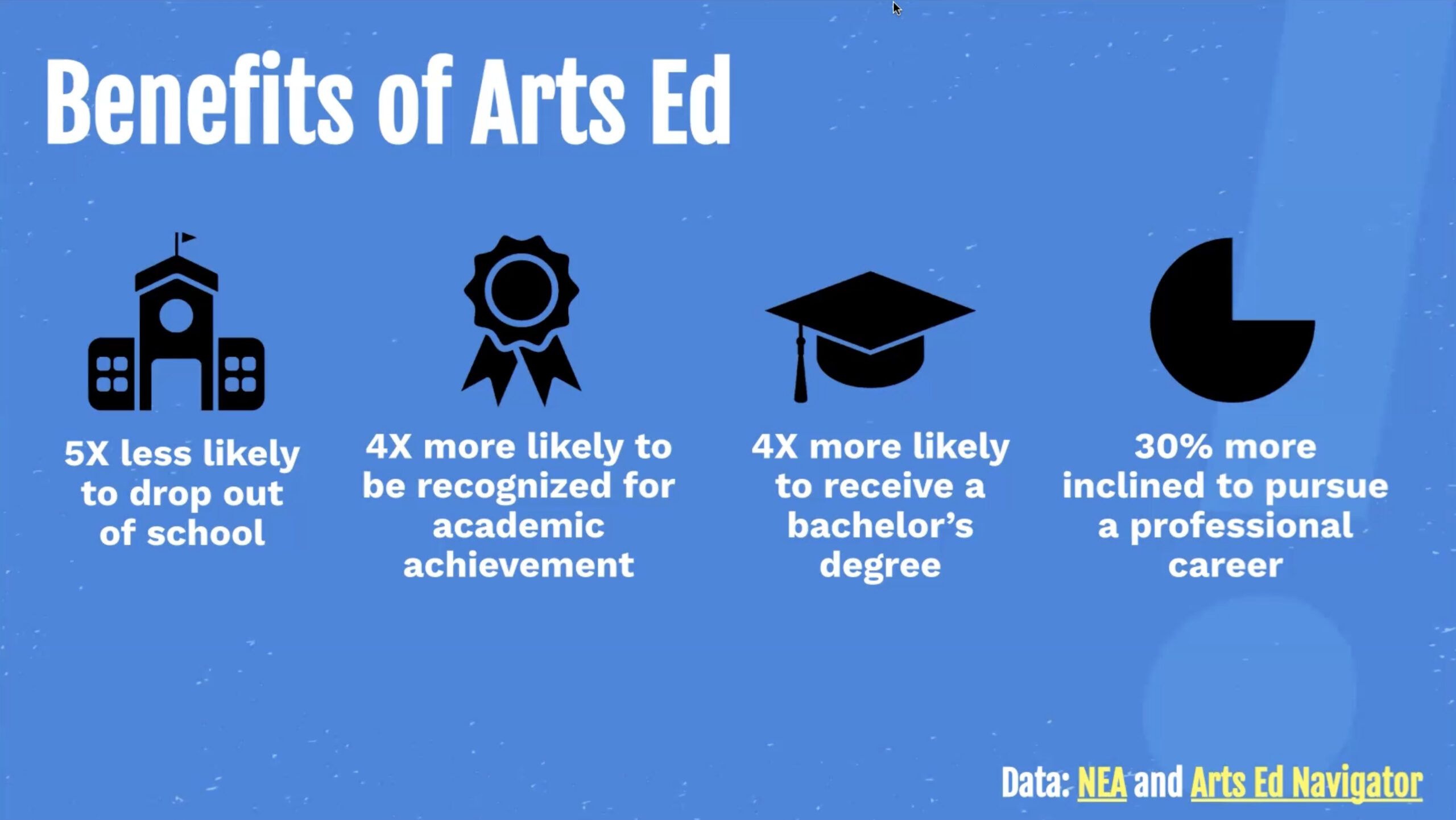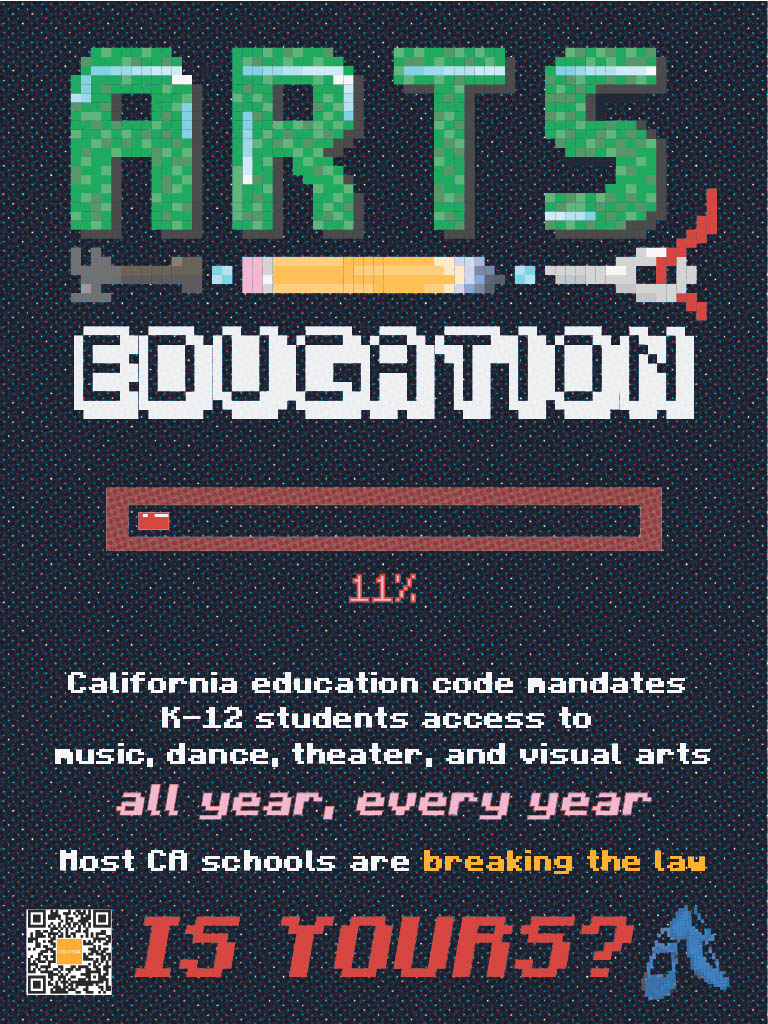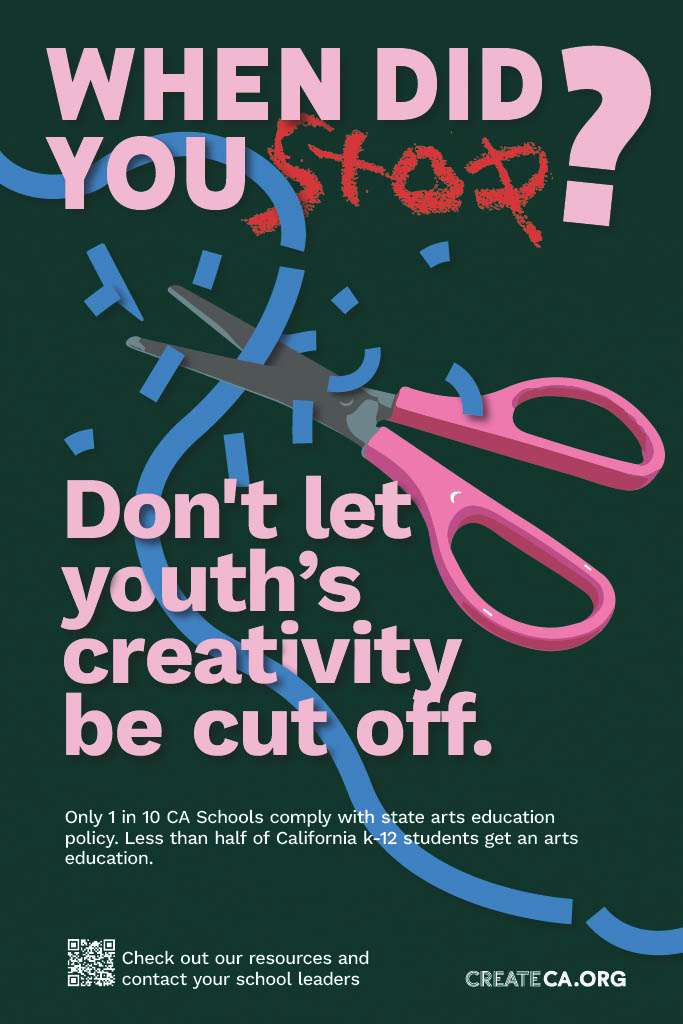Designing Advocacy: Arts Education + Graphic Design Implementation

With support from the California Arts Council and in partnership with Create CA, a nonprofit that advocates for high-quality arts education for all students, this ArtCenter ACX studio in Spring 2024 empowered high school and early college students to use their creativity to advocate for arts education in public schools since only 11% of California public schools meet the state’s standards-based art education mandate.
These students from across California met virtually, exploring what makes a successful social justice message and examined campaigns that caught on culturally and changed public opinions. Students were introduced to the elements and principles of effective advocacy design along with the practical applications of the various digital tools that designers use today.
Students sought to bring their voice to life by examining the range of choices that go into creating a not-so-simple “simple” graphic design. Their final poster creations were showcased in a virtual gallery and an art show at the California State Summer School for the Arts. Students also received printed copies of their work as well as a version of Adobe Creative Suite.

Research and Project Development
The kick-off session welcomed students from across the state of California – who met virtually – to learn more about social graphic advocacy and the design process by exploring their own creativity and working on a real-world issue.
Presentations from Create CA partners revealed that the State of California requires public schools to provide student access to arts programming – visual, music, dance, theater – throughout the school year. Only 11 percent of schools abide by that mandate. The posters created in this studio would call attention to this inadequacy as well as celebrating the power of art to change lives, communities and cultures.
The lack of art programs reflects a racial and economic inequality; wealthier students typically join private afterschool arts programs while those in rural or from low-income communities often do without.
Create CA representatives stressed that they wanted this campaign to come from students in the communities that are affected. “If the audience is your community, you may know images of the arts that would resonate with them,” remarked one partner.
The barriers for schools to provide arts education were discussed: no suitable spaces, lack of supplies, and [lack of] credentialed teachers. Students shared what barriers they personally have experienced or seen at their own schools.
Switching gears, Create CA partners shared how incorporating art into a young person’s education dramatically improves academic success and later in their professional career. Studying the arts, they continued, allows students to engage in self-discovery, learning how to work with others and understanding their own emotions. Overall, art can help students see the world in new, exciting ways.

“I want to portray that art can be a way of pushing for change, and art can be like a medium for people who are feeling like they are unheard and without a voice.”
Johvana Ordonez, student
Prior to the first class, students were asked to sketch out and describe what message they want to get across, along with a possible Call to Action. Students explained their ideation, who they envision as their main audience and where they imagine the poster could be incorporated into the landscape. Also, they shared personal connections to the concepts and how their background – cultural identity, etc., — could be infused into their design thinking.
Students reviewed how successful iconic historical campaigns gained traction; they examined how engaging imagery and a straightforward message — in the case of the AIDS epidemic, marriage equality and cigarette smoking – can affect public opinion and change minds.
For their first assignment, students choose a social justice/advocacy campaign that influenced them; by describing what elements moved them, students began to realize the importance of details, the careful consideration of words and the bravery of the artist to call attention to this issue.
Students examined how the campaign to protest The Dakota Access Pipeline, started locally with the with the Standing Rock Sioux Tribe, but worked its way onto a global stage with the final keywords of “Water is Life” that resonated across cultures.
A series of questions were introduced to students that could be used for this design and other design projects. What are your overall goals? What do you want people to do? Who is your intended audience? What is the best way to reach them? How will we know if we communicated well enough to them?
Throughout the studio, students engaged in homework, in-class explorations and brainstorming sessions that helped them discover and hone their imagery and words. They were encouraged to use their own voice and point of view which would make for a richer, more authentic visual experience. The more personalized the message, the more it could move hearts and minds, especially if the initial design/imagery is eye-catching.

“I’m a post-grad student and I studied art. I’m interested in design that intersects advocacy with art that’s meaningful. I usually work in more analogue ways, but learning Illustrator is a good thing to know.”
Tzasna Perez Espinosa, ArtCenter Alumni
Outside of the classroom, students shared their artwork and comments via a Miro Board where they could learn from one another, find inspirational links/design resources and review past work.
Often joining the classroom discussion was local artist Audrey Chan, known for her research-based projects that illuminate political and cultural identities. Chan provided insight and urged students to mine their own personal experiences into their creation. “Dig deep into why art education matters to you,” she told them.
Chan advised students to check out specific artists and illustrators for inspiration, and looking at their current work, she discussed color palettes, positioning and messaging options. She offered suggestions and constructive critique in how students can move forward in their design.
A discussion about unfair representations of ethnic communities in design/media challenged students to create design imagery that breaks overused and tiresome stereotypes. Students were introduced to the Design Justice Principles from the Design Justice Network, and asked how would they like their ethnicity to be represented? What style or aesthetic complements their community?

“The design process can be very personal and I was proud that these students were open and vulnerable with each other, and how they worked with Create CA. I wanted the student to learn that co-designing means sharing the power with others. Let your work educate others and know that your voice matters.”
Joel Garcia, Faculty
Bringing shape and form to the messaging
The studio also featured practical instructions of design fundamentals. Since students each received a free copy of Adobe Creative Suite for participating in this studio, they were given hands-on instruction on the ins and outs of the design applications.
Students also were introduced to other popular software applications, Procreate and Illustrator.
Through tutorials, online videos and in-class demonstrations, students learned how fonts, composition and color can support the thematic umbrella of their messaging. Students scrutinized examples on other imagery and asked “What worked? What didn’t?” Other sessions offered a deep dive into font selection, textures, logo placement, making halftones, creating vectors, etc.
As they refined their concepts, students also created mockups of how their posters would look as billboards, bus benches, stickers, etc.
Because they would have their posters professionally printed, students were made aware of all technical specifications that artists need to know before they place an official order, such as type of paper, color spaces, etc. Students learned the importance of high-resolution files and correct file types for printing purposes.
Presentation preparation was also covered prior to the final studio when students would share their final project process, ideation and execution. During the presentation, they would describe their audience, what is their ‘drum beat’ (the Call to Action), and the overall concept as displayed in their poster. Scripts would be created to help students stay on subject.
Outcomes
 close
close
What Does Arts Education Mean to You? What Does Arts Education Mean to Society?
Read moreAimee Spriggs
On a muted blue background the text is simple white lettering; except for the word Arts which has each letter relating to creativity including drawing pencils and brushes as well as cameras and dance steps. The question refers to the myriad of ways that arts education can be expressed, interpreted and incorporated into everyday society.
 close
close
Creativity is Medicine Honor the Mandate / Crear es Sanar Honren el Mandato
Read moreEllie Guzman
Employing a background image from ancient Mexican sculpture and aesthetic, the imagery is presented in English and Spanish versions to encourage those with Mexican heritage to embrace the value of art and creativity as culturally important and necessary. White lettering also features ancient Mexican design elements.
 close
close
Education Without the Arts is Incomplete
Read moreKiki Liu
Imagery of large colorful puzzle pieces – with one piece shown set off to the side – illustrates the importance of a full education to create a complete “puzzle.” The black background emphasizes the color and depth of the puzzle pieces. The white lettering also pops against the darkness and emphasizes the words Education, Arts and Incomplete.
 close
close
Arts Education
Read moreMaya Castillo
A close-up of a computer monitor is the inspiration for this poster that depicts a loading graphic at only 11 percent – the number of schools that comply with the arts education mandate. The old computer-styled graphics and boxy font style explains how schools are breaking the law, and asks readers if their school is compliant.
 close
close
When Did You Stop?
Read moreTzasna Perez Espinosa
Giant scissors cutting through ribbon-like strands confront readers about youth being “cut off from creativity.” The headline features red printed letters except for the word “stop” which is presented in chalk-like lettering demonstrating how childlike wonder diminishes without creative arts expression. Smaller text underneath encourages readers to contact their schools.
 close
close
CA Back Your Rights To Arts Education
Read moreSierra Acosta
A rich blue background with ancient Mexican symbols, silhouettes of scalloped paper picado and adorned on the top with a brilliant yellow chrysanthemum, this poster draws upon Mexican culture and arts to advocate for arts education in California.
 close
close
Support Arts Education
Read moreLucia Cresci de la Torre
This series of five posters depict four art pathways – theatre, music, etc. – and the bigger life lessons that are learned from participating in that artistic expression: compassion, community, culture and cooperation. The central poster, the “face” of a graduating student, features four elements from the other posters: musical instrument, paint and palette, dancing figure and stage lights.
 close
close
Help Art Change the World
Read moreJohvana Ordonez
A brown woman with long black hair holds up a pen/brush as a gesture of protest in a crowd. Her glasses have sparkles. The flower in the pen radiates powerful light rays outward that cut through the darker background. Readers are encouraged to Sign the Pledge today via a QR code.
